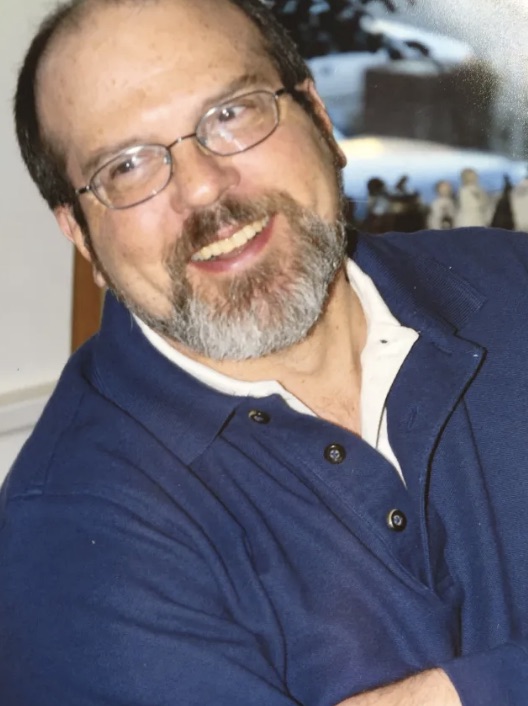|
Getting your Trinity Audio player ready...
|
OWN VOICE. ~ InPerspective by Gregg Dieguez —
Yes, you. What we’re in is being called the worst California drought on record, but that’s wrong. The Middle Ages had two long ones, at 141 and 220 years, and those were solely due to normal climate shifts (they wiped out several civilizations, including the Mayans and Tiwanaku). Our problem today is a combination of a human-caused Climate Crisis, atop a normal climate shift. Well, that, and we have too many people to continue to live the way we have.
Footnotes: to use, click the bracketed number and then click your browser Back button to return to the text where you were reading.
Images: Click to enlarge for improved readability in a new window.
This is too big a topic to cover in one article, so let’s focus on two things: the reality of the drought, and the implications for local water supply in Half Moon Bay and Pacifica. We’ll cover Montara’s water district (MWSD) later, because there’s no new report from there, yet. And we’ll cover Solutions in another article, but we’ll mention some Implications here, as a lead-in to our required mutual thought process. This article is divided into 3 sections, and you can skip to what you want to read:
It’s two problems at once.
Sizzling temperatures are baking the West, with readings about 15 to 30 degrees or more above normal bringing dangerous conditions and highs above 100 degrees to 40 million people. Records have been falling left and right as temperatures reach extreme levels, a number of U.S. cities climbing near or above 110.”
And then there’s a lack of precipitation, and it’s melting and evaporating too soon and too much.
“The West is no stranger to drought, but climate change is making it worse. Severe dryness covered California and Nevada just five years ago, from 2012 to 2016, and the Southwest has been in drought for much of the past two decades, punctuated by rare wet years. Experts say this year is unusual because extreme drought conditions are so widespread and have intensified quickly. They are likely to grow even worse this summer. “
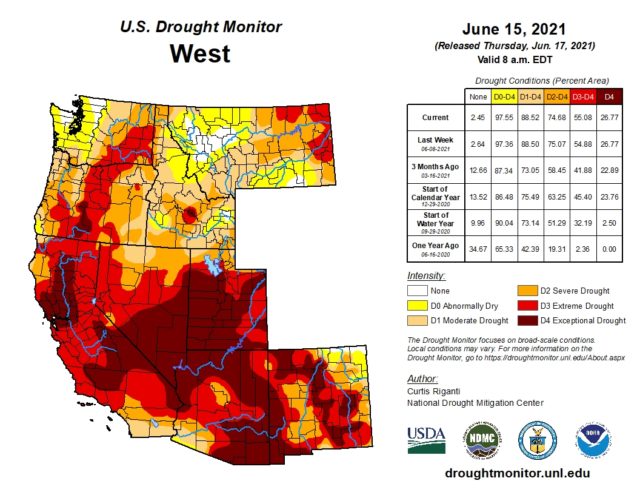
56% of the West is currently in the absolute highest category “Exceptional Drought”. Not Drought, or Severe Drought, or Extreme Drought, but The Absolute Worst Drought we can measure.
However, we saw this coming, some people as far back as 130 years ago[3]. And the scientist who measured those Medieval droughts said: “California, like Tiwanaku, presents “a classic case of people building themselves beyond the carrying capacity of the land,” which is determined not by wet times but by dry ones. “What we’ve done in California is fail to recognize that there are lean times ahead,” said Dr. Stine, “and they are a lot leaner than anything we’ve come up against” in the modern era.”
The Urban Water Management Plans for all water agencies were extended by a year, instead of the normal 5 year intervals. They are due this year, and Half Moon Bay’s Coastside County Water District (CCWD) and Pacifica’s North Coast County Water District (NCCWD) just posted their draft plans. They also told you to cut back on watering, but that’s peanuts compared to the real risks.

Almost all the water districts in San Mateo and Santa Clara County (MWSD is one exception) get the vast majority of their water from the SFPUC Hetch Hetchy System, as members of BAWSCA (Bay Area Water Supply & Conservation Agency). That agency buys SFPUC water on behalf of 24+ agencies and has longstanding contracts for supply and operations. It issued guidance to member agencies on April 9, 2021 about the level of supplies to be expected. That analysis contains updated information on the Bay Delta Plan, the result of a longstanding lawsuit which requires minimum water flows in the Tuolumne River[1] to prevent its death (like the Colorado River). Until now, BAWSCA and SFPUC had never considered a rationing plan with cutbacks more than 20%. Now they’re looking at 50%+ depending upon the severity and duration of droughts.[2] And while these projections assume the same SFPUC allocation percentages will be used for water cutbacks above 20%, there is no guarantee of that, and SFPUC has previously retained a slightly increasing percentage of its water the greater the percentage cutbacks. So these analyses could be optimistic.
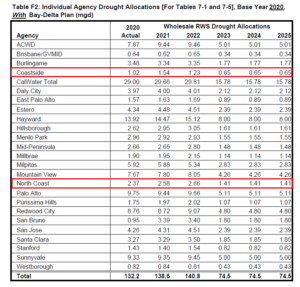
Further, every agency is slightly different (click to view table at right). CCWD has supplies from local creeks. Pacifica produces some recycled water. And so on. Based on a quick review of the draft UWMP’s for each agency, here are some tidbits:
Pacifica (NCCWD)
-
- Further conservation in Pacifica is expected to reduce residential consumption by 17% per person by 2045. Thus, any shortages you see are IN EXCESS of that amount of savings. Without further conservation, a 54% cutback in 2045 would be more like a 71% cutback.
- The water from San Pedro Creek has not been used since 1997. During drought years, expected creek production would only be 2.45% of normal year creek flows, and at best those are a small percent of city need – so it’s not much help.
- Recycled water is only used for irrigation, and 46% of that water was produced by adding potable water.
- The district had previously reported water losses of 9% (!!), but… “The District’s 2020 water loss audit report had not been completed at the time this Plan was prepared. It could not demonstrate whether the distribution loss standards enacted by the State Water Resources Control Board pursuant to CWC § 10608.34 have been met. However, the SWRCB has yet to establish these standards “. Now THAT’S astounding. The regulators can’t keep up with the drought?!?!
- “Without including differences in rainfall, expected temperature increases will lead to future evaporation and desiccation water
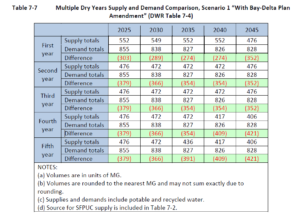
NCCWD supply shortfalls losses of 7.6-8.6% from present-day conditions by 2040 and by 24.7-29.4% from present-day conditions by 2100. In critically dry years, these reductions in annual runoff at Hetch Hetchy would be significantly greater, with runoff decreasing up to 46.5% from present day conditions by 2100 utilizing the same climate change scenarios.”
- Supply Shortfalls: NCCWD isn’t showing the percentages on its tables of water supply availability, but you can do the math by enlarging the table at right. The shortfall compared to supply is about 50% in 2045, for multiple dry years.
- Member agencies used to show 8 year scenarios, with a peak cutback of 68%. I can guess why they no longer show 8 years, and why they’re not showing percentages.
Half Moon Bay (CCWD)
- Water losses have improved markedly since 2016, and are down from 11.28% to 4.03%
- During a multiple year drought, supply from BAWSCA would be down 49% from Normal Years, but local supplies help. (Table 7.4)
- The supplemental supply from Denniston and Pilarcitos Creeks and other groundwater provides some water during a drought. Those supplies decline by as much as 80% over a 5 year drought (Table 7-6), but help a little, and more costs are being spent for new water supply projects.
- Overall supply and demand is shown in Table 7-18, but it’s unclear in what year that table assumes the drought starts, and the cutbacks begin. As point #5 under Pacifica states, the further out in time we go, the less the water supply will be, due to the Climate Crisis.
- Assuming you believe continued conservation will suppress long term demand, the shortfalls at CCWD are shown in the graph at right. In the first dry year, shortfalls are from 24 to 30% depending on the starting year of the drought. In the 5th dry year, shortfalls range from 53% to 59%. If conservation cannot achieve those goals, the shortfalls would be greater.
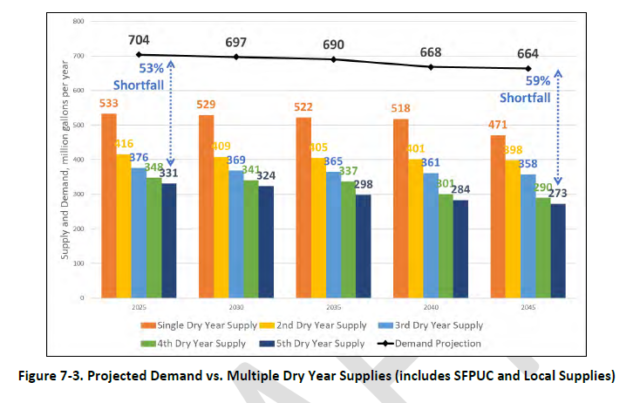
Let me add a caveat here: there are lots of numbers from several sources, using different years and different denominators. Add to that some inconsistencies I’ve found and am awaiting answers regarding. The Bay Delta Plan might NOT be adopted (but that’s not how BAWSCA and I are betting). The required flow release could be higher or lower than 40% (see footnote [1]). Conservation could be better or worse than the 17% hoped for. The % allocation from SFPUC to member agencies could be less (it certainly won’t be more). Population growth could be more or less than expected. And then throw in a simple fact: we don’t know how bad droughts are going to be: will they be 100+ years or 4 years, and how dry is dry? As I get clarification, I’ll publish amended findings. What is certain are two things: 1) the uncertainty about the magnitude of the problem, and 2) the certainty that it could be Very Bad.
3. Implications…
An hydrologist told me “the entire water system in the state of California is designed for a hydrology that no longer exists.” The loss of snowpack means that water is not stored in the mountains until we need it in the summer – we now need to capture and store what we get when we get it – and we don’t, due to lack of storage – so most of it runs off. Most of our dams are for flood control, not water storage. Clearly we can make and store more water. But it’s expensive, and it takes decades to build what we’ll need. Fun fact, 20% of the electricity and over 30% of the natural gas used in Calif. is spent just moving water: your sewage, and the “Big Lift” of water downstate and over the Tehachapi mountains into LA, and so on. So it’s not just the construction cost of new infrastructure, it’s the operation, maintenance and asset replenishment of that infrastructure which will cost even more.
Previously, I had cited Pacific Institute studies on the cost of ‘New Water’ as 5 to 7 times current water costs. At a recent webinar held by Sen. Josh Becker, Gary Kremen, a Director of Valley Water in Santa Clara said they are spending 10 TIMES the normal cost to fill their water needs. And any new population we add will be creating more need for that very expensive water.
We could also shrink our agricultural water use: stop eating almonds, growing cotton, etc. And there are costs and risks to that approach as well. Oh, and Breweries…
At the same webinar, Felicia Marcus, who was manager of the California State Water Resources Control Board, has changed her tune in the years since she spoke at one of our MIT Energy & Environment events. Half a dozen years ago, her message was that ‘we have it under control; we’ll do X and Y and we’ll be OK’. Now, her message is “we can’t conserve our way out of this drought”.
Finally, some of Becker’s panelists admitted that they were beyond Worried; they are now ‘a little bit Scared’. Even the trees agree it’s a megadrought…
So when your city or town endorses plans to grow, even by only 1% a year, it is saying “we’re going to cause water security to go down and water prices to go up for existing residents, in order to benefit the real estate profiteers creating the housing. Tough on you.” So what do we do about that? We’ll cover Solutions in the next article, but for starters MWSD is getting a legal opinion tonight (6/17/21) on what is required to establish a water moratorium on new connections, and some residents have already asked for it. We have a major sustainability problem, that is clear. Now what do we do? How much does it cost? And who pays?
FOOTNOTES:
[1] Bay Delta Plan Requirements from BAWSCA April 9, 2021 memo to member agencies
Adoption of the 2018 Bay-Delta Plan Amendment
In December 2018, the State Water Resources Control Board (SWRCB) adopted amendments to the Water Quality Control Plan for the San Francisco Bay/Sacramento-San Joaquin Delta Estuary (Bay-Delta Plan Amendment) to establish water quality objectives to maintain the health of the Bay-Delta ecosystem. The SWRCB is required by law to regularly review this plan. The adopted Bay-Delta Plan Amendment was developed with the stated goal of increasing salmonid populations in three San Joaquin River tributaries (the Stanislaus, Merced, and Tuolumne Rivers) and the Bay-Delta. The Bay-Delta Plan Amendment requires the release of 30-50% of the “unimpaired flow” on the three tributaries from February through June in every year type. In SFPUC modeling of the new flow standard, it is assumed that the required release is 40% of unimpaired flow. If the Bay-Delta Plan Amendment is implemented, the SFPUC will be able to meet the projected water demands presented in this UWMP in normal years but would experience supply shortages in single dry years or multiple dry years. Implementation of the Bay-Delta Plan Amendment will require rationing in all single dry years and multiple dry years.
[2] BAWSCA supply cutbacks to member agencies
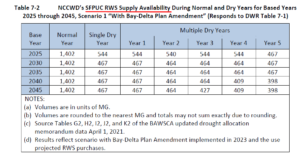
The severity of the cutback depends on what numbers you use for a denominator. Local agencies have been conserving for some time, and cutbacks from those numbers are lower than cutbacks from what used to be a “normal” year. The table at right shows BAWSCA supply numbers for Normal Years, compared to current expectations. In year 5 of a drought (our most recent one was 4 years), 398 million gallons are supplied compared to Normal year supplies of 1,402MG – that’s a 72% cutback. Of course, we’re in a “new normal”.
[3] The Visionary John Wesley Powell Had a Plan for Developing the West, But Nobody Listened
“[Powell] told them all too rightly that the West offered not enough water to reclaim by irrigation more than a tiny fraction of its land. Their dreams of a verdant West needed to be tempered and shaped to reality. Powell might as well have told them the Earth was flat. The senators were outraged.”
More From Gregg Dieguez ~ InPerspective
Mr. Dieguez is a native San Franciscan, longtime San Mateo County resident, and semi-retired entrepreneur who causes occasional controversy on the Coastside. He is a member of the MCC, but his opinions here are his own, and not those of the Council. In 2003 he co-founded MIT’s Clean Tech Program here in NorCal, which became MIT’s largest alumni speaker program. He lives in Montara. He loves a productive dialog in search of shared understanding.



